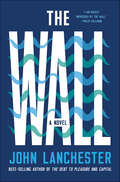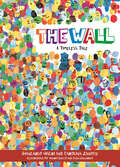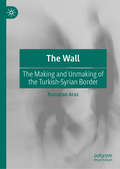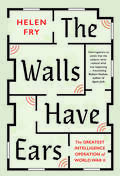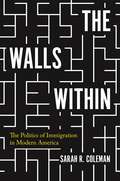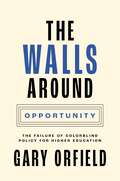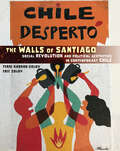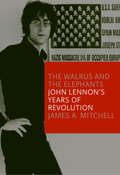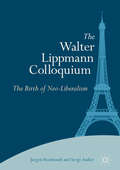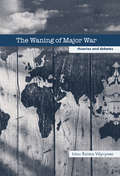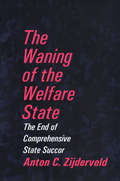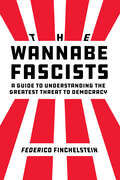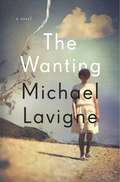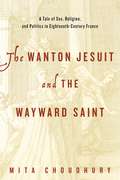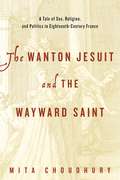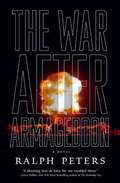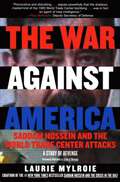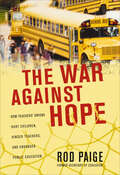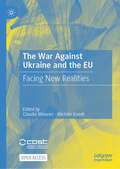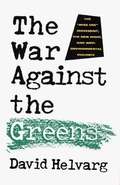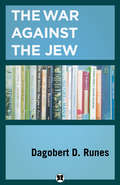- Table View
- List View
The Wall: A Novel
by John LanchesterShortlisted for the 2020 Orwell Prize "Thrilling…A topical and deftly satirical novel." —Anna Mundow, Wall Street JournalIn this taut, dystopian tale, an island nation ravaged by the Change has built an enormous concrete barrier around its coastline—the Wall. Joseph Kavanagh, a new Defender, has one task: to protect his section of the Wall from the Others, the desperate souls trapped amid the rising seas outside. A blend of the most compelling issues of our time—climate change, increasing fear, widening divisions—The Wall is a suspenseful story of love, trust, and survival.
The Wall: A Timeless Tale
by Giancarlo Macri Carolina ZanottiA king and his servant learn about the benefits of diversity and the damage that barriers can do in this colorful tale. In this moving and valuable story, a king banishes anyone who looks different than him and builds a wall to keep them away. His kingdom was once flourishing with singers and sculptors, dancers and astronomers, and everyone in between. Now, most of the people are gone. Once he sees how lonely his side of the wall has become, he realizes where he went wrong and gains a new appreciation for his diverse and talented kingdom. With a visually engaging style that makes a complex lesson simple, this story shows children how a community can be harmed when barriers are built and how it thrives when people come together. &“The Wall shows in brilliant color just how vibrant your life can be when you break down barriers and work toward inclusion, which is a wonderful message for readers of any age.&” —Katherine Kleffner, blogger, The Nerdy Girl Express &“A clever ebb and flow of colors and shapes that will have young readers, as well as the king, quickly seeing the errors of exclusionary ways.&”—Foreword Reviews &“The Wall: A Timeless Tale is a joyful celebration of diversity, bar none!&” —Storywraps &“Macri and Zanotti . . . make it clear that shutting people out only weakens a kingdom, and they do it with laughter, not argument.&” —Publishers Weekly This is a fixed-format ebook, which preserves the design and layout of the original print book
The Wall: The Making and Unmaking of the Turkish-Syrian Border
by Ramazan ArasThrough an anthropological analysis, this book uncovers life stories and testimonies that relate the processes of separation as a result of the constructed political borders of nation states newly founded on the inherited territories of the Ottoman Empire. As it recounts ruptured social, cultural, political, religious, and economic structures and autochthonous bonds, this work not only critically analyzes the making of the Turkish-Syrian border through an exploration of statist discourse, state practices and the state’s diverse apparatuses, but further analyzes the “unmaking” border practices of local subjects in the light of local Kurdish people’s counter perceptions, discourses, family histories, narratives, and daily practices—each of which can be interpreted as a practice of local defiance, resilience, and adaptation in everyday life.
The Walls Have Ears: The Greatest Intelligence Operation of World War II
by Helen FryA history of the elaborate and brilliantly sustained World War II intelligence operation by which Hitler’s generals were tricked into giving away vital Nazi secrets At the outbreak of World War II, MI6 spymaster Thomas Kendrick arrived at the Tower of London to set up a top secret operation: German prisoners’ cells were to be bugged and listeners installed behind the walls to record and transcribe their private conversations. This mission proved so effective that it would go on to be set up at three further sites—and provide the Allies with crucial insight into new technology being developed by the Nazis. In this astonishing history, Helen Fry uncovers the inner workings of the bugging operation. On arrival at stately-homes-turned-prisons like Trent Park, high-ranking German generals and commanders were given a "phony" interrogation, then treated as "guests," wined and dined at exclusive clubs, and encouraged to talk. And so it was that the Allies got access to some of Hitler’s most closely guarded secrets—and from those most entrusted to protect them.
The Walls Within: The Politics of Immigration in Modern America (Politics and Society in Modern America #136)
by Professor Sarah ColemanA history of the battles over US immigrants’ rights since 1965—and how these conflicts reshaped access to education, employment, civil liberties, and moreThe 1965 Hart-Celler Act transformed the American immigration system by abolishing national quotas in favor of a seemingly egalitarian approach. But subsequent demographic shifts resulted in a backlash over the social contract and the rights of citizens versus noncitizens. In The Walls Within, Sarah Coleman explores those political clashes, focusing not on attempts to stop immigration at the border, but on efforts to limit immigrants’ rights within the United States through domestic policy. Drawing on new materials from the Carter, Reagan, and Clinton administrations, and immigration and civil rights organizations, Coleman exposes how the politics of immigration control has undermined the idea of citizenship for all.Coleman shows that immigration politics was not just about building or tearing down walls, but about employer sanctions, access to schools, welfare, and the role of local authorities in implementing policies. In the years after 1965, a rising restrictionist movement sought to marginalize immigrants in realms like public education and the labor market. Yet throughout the 1970s and 1980s, restrictionists faced countervailing forces committed to an expansive notion of immigrants’ rights. In the 1990s, with national politics gridlocked, anti-immigrant groups turned to statehouses to enact their agenda. Achieving strength at the local level, conservatives supporting immigration restriction actually acquired more influence under the Clinton presidency than even during the so-called Reagan revolution, resulting in dire consequences for millions of immigrants.Revealing the roots behind much of today’s nativist sentiment, The Walls Within examines debates about who is entitled to the American dream, and how such dreams can be subverted for those already calling the country home.
The Walls around Opportunity: The Failure of Colorblind Policy for Higher Education (Our Compelling Interests #6)
by Gary OrfieldThe case for race-conscious education policyIn our unequal society, families of color fully share the dream of college but their children often attend schools that do not prepare them, and the higher education system gives the best opportunities to the most privileged. Students of color hope for college but often face a dead end.For many young people, racial inequality puts them at a disadvantage from early childhood. The Walls around Opportunity argues that colorblind policies have made college inaccessible to a large share of students of color, and reveals how policies that acknowledge racial inequalities and set racial equality goals can succeed where colorblindness has failed.Gary Orfield paints a troubling portrait of American higher education, explaining how profound racial gaps imbedded in virtually every stage of our children’s lives pose a major threat to communities of color and the nation. He describes how the 1960s and early 1970s was the only period in history to witness sustained efforts at racial equity in higher education, and how the Reagan era ushered in today’s colorblind policies, which ignore the realities of color inequality. Orfield shows how this misguided policy has resegregated public schools, exacerbated inequalities in college preparation, denied needed financial aid to families, and led to huge price increases over decades that have seen little real gain in income for most Americans.Drawing on a wealth of new data and featuring commentaries by Stella Flores and James Anderson, this timely and urgent book shows how colorblind policies serve only to raise the walls of segregation higher, and proposes real solutions that can make higher education available to all.
The Walls around Opportunity: The Failure of Colorblind Policy for Higher Education (Our Compelling Interests #8)
by Gary OrfieldThe case for race-conscious education policyIn our unequal society, families of color fully share the dream of college but their children often attend schools that do not prepare them, and the higher education system gives the best opportunities to the most privileged. Students of color hope for college but often face a dead end.For many young people, racial inequality puts them at a disadvantage from early childhood. The Walls around Opportunity argues that colorblind policies have made college inaccessible to a large share of students of color, and reveals how policies that acknowledge racial inequalities and set racial equality goals can succeed where colorblindness has failed.Gary Orfield paints a troubling portrait of American higher education, explaining how profound racial gaps imbedded in virtually every stage of our children&’s lives pose a major threat to communities of color and the nation. He describes how the 1960s and early 1970s was the only period in history to witness sustained efforts at racial equity in higher education, and how the Reagan era ushered in today&’s colorblind policies, which ignore the realities of color inequality. Orfield shows how this misguided policy has resegregated public schools, exacerbated inequalities in college preparation, denied needed financial aid to families, and led to huge price increases over decades that have seen little real gain in income for most Americans.Now with a new afterword that discusses the 2023 Supreme Court decision to outlaw affirmative action in college admissions, this timely and urgent book shows that the court&’s colorblind ruling is unworkable in a society where every aspect of opportunity and preparation is linked to race, and reveals the gaps in the opportunity pipeline while exploring the best ways to address them in light of this decision.
The Walls of Santiago: Social Revolution and Political Aesthetics in Contemporary Chile (Protest, Culture & Society #30)
by Eric Zolov Terri Gordon-ZolovA photo-illustrated record of Chilean protest art, along with reflections on artistic antecedents, global protest movements, and the long shadow cast by Chile’s authoritarian past. “This is an excellent and unique contribution to our understanding of protest art. It is the first substantive treatment in English of an important social movement and a significant contribution to the political impact of the COVID-19 pandemic.”—T.V. Reed, Washington State University From October 2019 until the COVID-19 lockdown in March 2020, Chile was convulsed by protests and political upheaval, as what began as civil disobedience transformed into a vast resistance movement. Throughout, the most striking aspects of the protests were the murals, graffiti, and other political graphics that became ubiquitous in Chilean cities. Authors Terri Gordon-Zolov and Eric Zolov were in Santiago to witness and document the protests from their very beginning. The book is beautifully illustrated with over 150 photographs taken throughout the protests. Additional photos will be available on the publisher’s website. From the introduction: In the conclusion, we take stock of the crisis of the nation-state in the contemporary era. This chapter brings events into the present moment, noting the ways President Piñera took advantage of the COVID-19 pandemic to reclaim the streets of Santiago, a phenomenon echoed in countries across the globe. While most of the global protest movements were forced to go underground (or into the ether), the Black Lives Matter movement surged in the United States and drew massive amounts of support both domestically and abroad, suggesting a continued wave of grassroots protests. We close with reflections on the continued relevance of walls in a virtual world, the testimonial role that protest graphics play, and the future outlook for revolutionary movements in Chile and worldwide.
The Walrus and the Elephants
by James A. MitchellNineteen-seventy-one was the year John Lennon left London and pop stardom for a life in New York City as a solo artist, record producer and activist looking to help end the war in Vietnam. He settled in Greenwich Village and quickly came to be seen by the leaders of the faltering anti-war movement as someone who was capable of reinvigorating it. The government was acutely aware of Lennon's power as well, seeing him as a viable threat to Nixon's reelection hopes, initiating extradition proceedings against him. Lennon's second solo album, Imagine, appeared in 1971, followed the following year by Sometime in New York City. Meanwhile, John and Yoko are searching for her daughter, a primary reason they came to America in the first place. And John is struggling to embrace feminism. The Walrus and the Elephants tells a double-barreled story of music and politics, how the personal is political and the political is personal, of upheavals in one life amid the larger cultural upheavals of an era. From the Hardcover edition.
The Walter Lippmann Colloquium
by Jurgen Reinhoudt Serge AudierThis book is an introduction to and translation of the 1938 Walter Lippmann Colloquium held in Paris, which became known as the intellectual birthplace of "neo-liberalism. " Although the Lippmann Colloquium has been the subject of significant recent interest, this book makes this crucial primary source available to a wide, English-speaking audience for the first time. The Colloquium features important--often passionate--debates involving well-known intellectual figures such as Walter Lippmann, Louis Rougier, Friedrich Hayek, Ludwig von Mises, Michael Polanyi, Jacques Rueff, Alexander R#65533;stow and Wilhelm R#65533;pke. Many of the topics addressed at the Colloquium, such as the proper methods of economic intervention, the relationship between the market economy and democracy, and the relationship between economic liberalism and political liberalism are issues that still vie for our attention in the aftermath of the Great Recession.
The Waning of Major War: Theories and Debates (Contemporary Security Studies)
by Raimo VäyrynenThis book is a systematic effort by leading international scholars to map the trends in major-power warfare and explore whether it is waxing or waning. The main point of departure is that major-power war as a historical institution is in decline. This does not mean, though, that wars between states are in general disappearing. While there is some convergence in the conclusions by individual authors, they are by no means unanimous about the trend. The articles explore different causes and correlates of the declining trend in major-power warfare, including the impact of the international structure, nuclear weapons, international law, multilateral institutions, sovereignty and value changes.
The Waning of the Welfare State
by Anton ZijderveldThe welfare state in postwar Western Europe has been extended and intensified in a spectacular manner. Today, "welfare" represents a complex mix of services covering health, education, welfare, the arts, leisure, and social security. Anton C. Zijderveld is of the opinion that Europe's vast, comprehensive welfare state is becoming leaner and meaner, heading down a more sober path toward decentralization and deregulation, which only, but not merely, secures order for its citizens and shields society's vulnerable. As the millennium approaches, Zijderveld believes Europe is experiencing a cultural renaissance and a socioeconomic and political reformation in which the market will flourish and civil society will prosper.The Waning of the Welfare State focuses on the transformation of the welfare state in Europe over a four-decade period. Zijderveld employs the democratic triangle theoretical model, in which democracy is viewed as a system in which state, market, and civil society are held in precious balance. If one component supersedes the other two, democracy is endangered. In its 1960s and 1970s heyday, the state took center stage at the expense of the market and civil society; social democracy was the prevailing ideology. In the 1980s the market triumphed, often at the expense of both the state and civil society; this was the decade of liberalism. Today, civil society prevails, albeit at risk of being injurious to state and market. Ideologically, this is the decade of conservatism.Zijderveld sees a future "Americanization" of European social policy producing a fortuitously balanced coalition of social democracy, liberalism, and conservatism; a place where safety and order, prosperity and economic participation, and social participation and meaningful interactions flourish equally. This transformation carries many risks. But it will, in the end, strengthen Europe's political, economic, and sociocultural stamina. If it also draws the Atlantic partners closer together, as Zijderveld believes it does, the chances of another European communist, libertarian, or fascist Gtterdommerung will remain remote. Zijderveld presents useful concepts in a highly organized fashion. He has produced a very important book for American readers who will, hopefully, discover, beyond the often vast differences, some basic similarities of structures and developments within the European welfare state.
The Wannabe Fascists: A Guide to Understanding the Greatest Threat to Democracy
by Federico FinchelsteinMeet today's almost fascists and learn the warning signs to intercept them on the road from populism to dictatorship. With The Wannabe Fascists, historian Federico Finchelstein offers a precise explanation of why Trumpism and similar movements across the world belong to a new political breed, the last outcome of the combined histories of fascism and populism: the wannabe fascists. This new type of populist politician is typically a legally elected leader who, unlike previous populists who were eager to distance themselves from fascism, turns to totalitarian lies, racism, and illegal means to destroy democracy from within. Drawing on almost three decades of research on the histories of fascism and populism around the world, this book lays out in clear language what the author calls the "four pillars of fascism"—xenophobia, propaganda, political violence, and ultimately dictatorship. Finchelstein carefully explains how and why wannabe fascists like Trump, Bolsonaro, and Modi embrace the first three pillars but don't quite succeed in dictatorship and total suppression of the popular vote. The Wannabe Fascists stresses the importance of preventing despots from reaching this tipping point and offers a clear warning for what's at stake.
The Wanting: A Novel
by Michael LavigneFrom the author of Not Me, this powerful novel about an Israeli father and his daughter brings to life a rich canvas of events and unexpected change in the aftermath of a suicide bombing. In the galvanizing opening of The Wanting, the celebrated Russian-born postmodern architect Roman Guttman is injured in a bus bombing, causing his life to swerve into instability and his perceptions to become heightened and disturbed as he embarks on an ill-advised journey into Palestinian territory. The account of Roman's desert odyssey alternates with the vivacious, bittersweet diary of his thirteen-year-old daughter, Anyusha (who is on her own perilous path, of which Roman is ignorant), and the startlingly alive witnessings of Amir, the young Palestinian who pushed the button and is now damned to observe the havoc he has wrought from a shaky beyond. Enriched by flashbacks to the alluringly sad tale of Anyusha's mother, a famous Russian refusenik who died for her beliefs, The Wanting is a poignant study of the costs of extremism, but it is most satisfying as a story of characters enmeshed in their imperfect love for one another and for the heartbreakingly complex world in which that love is wrought.
The Wanton Jesuit and the Wayward Saint: A Tale of Sex, Religion, and Politics in Eighteenth-Century France
by Mita ChoudhuryThis microhistory investigates the famous and scandalous 1731 trial in which Catherine Cadière, a young woman in the south of France, accused her Jesuit confessor, Jean-Baptiste Girard, of seduction, heresy, abortion, and bewitchment. Generally considered to be the last witchcraft trial in early modern France, the Cadière affair was central to the volatile politics of 1730s France, a time when magistrates and lawyers were seeking to contain clerical power. Mita Choudhury’s examination of the trial sheds light on two important phenomena with broad historical implications: the questioning of traditional authority and the growing disquiet about the role of the sacred and divine in French society. Both contributed to the French people’s ever-increasing disenchantment with the church and the king. Choudhury builds her story through an extensive examination of archival material, including trial records, pamphlets, periodicals, and unpublished correspondence from witnesses. The Wanton Jesuit and the Wayward Saint offers new insights into how the eighteenth-century public interpreted the accusations and why the case consumed the public for years, developing from a local sex scandal to a referendum on religious authority and its place in French society and politics.
The Wanton Jesuit and the Wayward Saint: A Tale of Sex, Religion, and Politics in Eighteenth-Century France
by Mita ChoudhuryThis microhistory investigates the famous and scandalous 1731 trial in which Catherine Cadière, a young woman in the south of France, accused her Jesuit confessor, Jean-Baptiste Girard, of seduction, heresy, abortion, and bewitchment. Generally considered to be the last witchcraft trial in early modern France, the Cadière affair was central to the volatile politics of 1730s France, a time when magistrates and lawyers were seeking to contain clerical power. Mita Choudhury’s examination of the trial sheds light on two important phenomena with broad historical implications: the questioning of traditional authority and the growing disquiet about the role of the sacred and divine in French society. Both contributed to the French people’s ever-increasing disenchantment with the church and the king. Choudhury builds her story through an extensive examination of archival material, including trial records, pamphlets, periodicals, and unpublished correspondence from witnesses. The Wanton Jesuit and the Wayward Saint offers new insights into how the eighteenth-century public interpreted the accusations and why the case consumed the public for years, developing from a local sex scandal to a referendum on religious authority and its place in French society and politics.
The Wanton Jesuit and the Wayward Saint: A Tale of Sex, Religion, and Politics in Eighteenth-Century France (Refiguring Modernism Ser. #22)
by Mita ChoudhuryThis microhistory investigates the famous and scandalous 1731 trial in which Catherine Cadière, a young woman in the south of France, accused her Jesuit confessor, Jean-Baptiste Girard, of seduction, heresy, abortion, and bewitchment. Generally considered to be the last witchcraft trial in early modern France, the Cadière affair was central to the volatile politics of 1730s France, a time when magistrates and lawyers were seeking to contain clerical power. Mita Choudhury’s examination of the trial sheds light on two important phenomena with broad historical implications: the questioning of traditional authority and the growing disquiet about the role of the sacred and divine in French society. Both contributed to the French people’s ever-increasing disenchantment with the church and the king. Choudhury builds her story through an extensive examination of archival material, including trial records, pamphlets, periodicals, and unpublished correspondence from witnesses. The Wanton Jesuit and the Wayward Saint offers new insights into how the eighteenth-century public interpreted the accusations and why the case consumed the public for years, developing from a local sex scandal to a referendum on religious authority and its place in French society and politics.
The War After Armageddon
by Ralph PetersShocking scenes of battle... unforgettable soldiers... heartbreaking betrayals... In this stunning, fast-paced novel, a ruthless future war unfolds in a 21st century nightmare: Los Angeles is a radioactive ruin; Europe lies bleeding; and Israel has been destroyed... with millions slaughtered. A furious America fights to reclaim the devastated Holy Land. The Marines storm ashore; the U. S. Army does battle in a Biblical landscape. Hi-tech weaponry is useless and primitive hatreds flare. Lt. Gen. Gary Flintlock Harris and his courageous warriors struggle for America's survival, with ruthless enemies to their front and treachery at their rear. Islamist fanatics, crusading Christians, and unscrupulous politicians open the door to genocide. The War After Armageddon thrusts the reader into a terrifying future in which all that remains is the horror of war, and the inspiration of individual heroism. A master at bringing to life the eternal soldier, Ralph Peters tells a riveting tale that honors those Americans who fight and sacrifice all for a dream of freedom.
The War Against America: Study of Revenge
by Laurie MylroieThe destruction of the twin towers of the World Trade Center and the attack on the Pentagon -- all within one hour on September 11, 2001 -- demonstrated America's shocking vulnerability to terrorism.Yet terror had already emerged on America's shores eight years earlier, when the mysterious terrorist mastermind, Ramzi Yousef (arrested after a botched attempt to down a dozen U.S. airlines) bombed the World Trade Center in an attempt to fell the buildings.His attacks were viewed as the harbinger of a new terrorism, carried out by an elusive enemy driven by religious fanaticism to unprecedented hatred of the United States.But is that perception accurate? A real-life detective story, The War Against America engages the reader in a gripping examination of the evidence regarding Yousef and his terrorism. It reveals the split between New York and Washington that emerged during the investigation and tells a terrifying tale of America left exposed and vulnerable following the mishandling of what was once the most ambitious terrorist attack ever attempted on U.S. soil.
The War Against Hope: How Teachers' Unions Hurt Children, Hinder Teachers, and Endanger Public Education
by Rod PaigeA former US Secretary of Education addresses the crisis in public schooling and the role teachers’ unions have played in its decline. Something is terribly wrong with America’s public-school system. For decades, we have seen test scores slide or stagnate—today, fewer than twenty percent of our nation’s twelfth graders are proficient in math, and our students rank near the bottom in science and math among the industrialized nations of the world—and achievement gaps persist or widen.So who’s responsible for the ongoing failure of our education system? In The War Against Hope, former Secretary of Education Rod Paige pulls no punches in his critical analysis of America’s crisis in the classroom. Without question, the greatest impediment to meaningful school reform is the enormous, self-aggrandizing power wielded by the teachers’ unions.In this vital, well-documented book, Paige takes an unflinching look at the power-hungry union leaders who have consistently placed their ambitions ahead of the needs of the teachers and the students whom they claim to serve. He also traces the history of the National Education Association (NEA) from its humble beginnings as an advocate of education excellence to its early radicalization by left-wing ideology.The War Against Hope is a disturbing account of the corruption, greed, and skewed values that have assaulted our schools, betrayed our teachers, and forsaken our children for far too long.
The War Against Parents
by Cornel West Sylvia Ann HewlettSylvia Ann Hewlett and Cornel West, a white woman and a black man, join to address the burning social issue of our time: the virtual abandonment of parents-poor and middle class-by America's business, political, and cultural elites. In what is both a visionary and intimate book, Hewlett and West present a blueprint for parent empowerment, which they call the Parents' Bill of Rights for the 21st century, which gives new value and dignity to the parental role and restores America's commitment to the well-being of children. With candor and hope for the future, the authors seek to unite America's 62 million parents behind an agenda that spans the divides of race, gender, and class.
The War Against Ukraine and the EU: Facing New Realities
by Claudia Wiesner Michèle KnodtThis open access book aims at discussing the manifold consequences that the War against Ukraine bears for the European Union and EU Studies. It takes stock of the fact that the Russian Attack on Ukraine and the ensuing War not only affects the Global Order, but also has challenged a number of established narratives and convictions for the European Union and its member states. The EU now needs to position itself in the changing world order. Concretely it needs to deal with a number of membership applications, internal and external challenges to liberal democracy, and the development of its strategic autonomy in a number of decisive policy fields. The book convenes experienced scholars, with chapters covering the following themes and fields: Theories, approaches and concepts in EU studies and IR; the EU and the changing European and Global Order; the War and defence of liberal democracy; Membership Politics; Energy Policy.
The War Against the BBC: How an Unprecedented Combination of Hostile Forces Is Destroying Britain's Greatest Cultural Institution... And Why You Should Care
by Patrick Barwise Peter YorkThere's a war on against the BBC. It is under threat as never before. And if we lose it, we won't get it back.The BBC is our most important cultural institution, our best-value entertainment provider, and the global face of Britain. It's our most trusted news source in a world of divisive disinformation. But it is facing relentless attacks by powerful commercial and political enemies, including deep funding cuts - much deeper than most people realise - with imminent further cuts threatened. This book busts the myths about the BBC and shows us how we can save it, before it's too late.
The War Against the Greens: The "Wise-Use" Movement, the New Right, and Anti-Environmental Violence
by David HelvargA shadowy backlash against environmentalists has begun to emerge in America, the most visible element of which calls itself the "Wise Use" movement. Among its stated goals are the unregulated use of timber, oil, gas, minerals, and range land, and the abolition of all environmental laws and agencies.
The War Against the Jew
by Dagobert D. RunesIn an introduction to The War Against the Jew, Dagobert D. Runes describes the war on the Jews, the history of Jewish hatred and prejudice. After that he gives a glossary of names, places, beings, writings, and words that describe this hatred.
